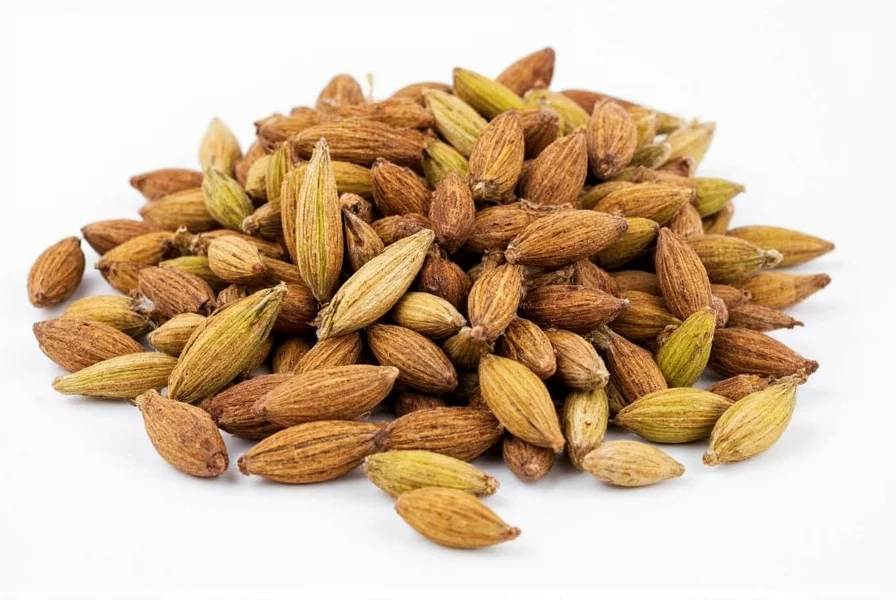Understanding what cardamom spice tastes like is essential for home cooks and professional chefs alike. This ancient spice delivers one of the most distinctive flavor profiles in the culinary world—a sophisticated combination that's simultaneously citrusy, floral, herbal, and warmly spicy. When you bite into a whole cardamom pod or inhale its aroma, you'll first notice bright lemon and orange notes, followed by delicate floral hints, then a subtle warmth reminiscent of cloves or cinnamon, all with a refreshing eucalyptus-like undertone.
The Complex Flavor Profile of Cardamom
Cardamom's unique taste comes from its complex chemical composition, containing over 30 different aromatic compounds. The primary flavor components include:
| Flavor Component | Description | Common Comparisons |
|---|---|---|
| Citrus Notes | Bright lemon and orange peel flavors | Freshly grated citrus zest |
| Floral Elements | Delicate, perfumed undertones | Lavender or rose (but less intense) |
| Warm Spices | Gentle heat without burning | Mixed with subtle cinnamon and clove notes |
| Eucalyptus/Mint | Cooling, refreshing finish | Mild menthol sensation on the palate |
Green vs. Black Cardamom: Understanding the Taste Differences
When exploring what cardamom spice tastes like, it's crucial to distinguish between the two main varieties:
Green Cardamom (True Cardamom)
Green cardamom (Elettaria cardamomum) offers the classic flavor profile most people associate with cardamom. It has a bright, citrus-forward taste with pronounced lemon and orange notes, delicate floral hints, and a clean, refreshing finish. The warmth is present but gentle—more aromatic than spicy hot. Green cardamom works beautifully in both sweet and savory applications, from Scandinavian pastries to Indian curries.
Black Cardamom (Bigger, Smokier Flavor)
Black cardamom (Amomum subulatum) delivers a dramatically different experience. It has a much more intense, smoky flavor with distinct camphor and menthol notes. The citrus elements are less pronounced, replaced by earthier, woodsy characteristics. This variety works best in robust savory dishes like stews, braises, and certain meat preparations where its powerful flavor won't overwhelm.

How Preparation Affects Cardamom's Flavor
The way you prepare cardamom significantly impacts what cardamom spice tastes like in your dish:
- Whole pods: Release flavor slowly, providing subtle background notes. Often used in rice dishes and braises.
- Cracked pods: Offer more pronounced flavor while preventing overpowering the dish.
- Seeds only: Deliver the most intense cardamom flavor without the fibrous pod material.
- Freshly ground: Provides the brightest, most vibrant flavor profile compared to pre-ground powder.
- Pre-ground powder: Convenient but loses volatile aromatic compounds more quickly, resulting in a less complex flavor.
Culinary Applications Based on Flavor Profile
Understanding the taste of cardamom spice helps determine its best culinary uses:
Sweet Applications
Green cardamom shines in desserts where its citrus and floral notes complement sweet ingredients. It's essential in Scandinavian baking (like Swedish kardemummabullar), Middle Eastern sweets, and Indian mithai. The spice pairs beautifully with chocolate, citrus fruits, pears, and stone fruits. When baking, use about 1/4 to 1/2 teaspoon of ground cardamom per recipe to avoid overwhelming other flavors.
Savory Dishes
In savory cooking, cardamom adds complexity to rice dishes (particularly biryani), meat marinades, and vegetable preparations. It works especially well with lamb, chicken, carrots, sweet potatoes, and cauliflower. In Indian cuisine, cardamom is a key component of garam masala. For Middle Eastern dishes like kabsa or maqluba, whole cardamom pods infuse rice with subtle flavor.

Common Misconceptions About Cardamom's Taste
Several misconceptions persist about what cardamom actually tastes like:
- Myth: Cardamom tastes primarily like mint
Reality: While it has subtle eucalyptus notes, it's not predominantly minty - Myth: Cardamom is extremely spicy and hot
Reality: It provides warm, aromatic notes without significant heat - Myth: Green and black cardamom are interchangeable
Reality: They have dramatically different flavor profiles and uses - Myth: Pre-ground cardamom tastes the same as freshly ground
Reality: Freshly ground offers significantly brighter, more complex flavors
Proper Storage to Preserve Cardamom's Flavor
To maintain the distinctive taste profile of cardamom, proper storage is essential. Whole cardamom pods retain their flavor much longer than ground spice—up to one year when stored properly. Keep cardamom in an airtight container away from light, heat, and moisture. For longest shelf life, store whole pods in the freezer. Ground cardamom loses potency within 3-6 months, so buy small quantities and grind only what you need for immediate use.
Flavor Pairings That Enhance Cardamom's Profile
Certain ingredients complement cardamom's complex flavor profile exceptionally well:
- Citrus fruits: Orange, lemon, and lime enhance cardamom's natural citrus notes
- Coffee: Creates a sophisticated flavor combination popular in Scandinavian and Middle Eastern traditions
- Chocolate: Particularly dark chocolate, which balances cardamom's brightness
- Cinnamon and cloves: Other warm spices that create harmonious blends
- Rose water: Complements cardamom's floral elements in Middle Eastern desserts
- Almonds and other nuts: Provide textural contrast to cardamom's aromatic profile
How Cardamom's Flavor Changes When Cooked
Understanding how cardamom spice tastes when cooked is crucial for recipe success. When heated, cardamom's volatile compounds transform, mellowing the bright citrus notes while enhancing the warm, spicy elements. In long-cooked dishes like stews or rice pilafs, add whole pods early in the cooking process. For baked goods or quick preparations, freshly ground cardamom added near the end preserves more of its delicate floral and citrus characteristics.
Substitutes When You Don't Have Cardamom
If you're wondering what spice tastes similar to cardamom, consider these alternatives (though none perfectly replicate its complex profile):
- A blend of equal parts cinnamon, nutmeg, and cloves with a touch of ginger
- Allspice with a hint of citrus zest
- Garam masala (which already contains cardamom among other spices)
- Coriander seed with a touch of citrus
Remember that substitutes only approximate cardamom's flavor—they won't provide the same nuanced experience as the real spice.











 浙公网安备
33010002000092号
浙公网安备
33010002000092号 浙B2-20120091-4
浙B2-20120091-4